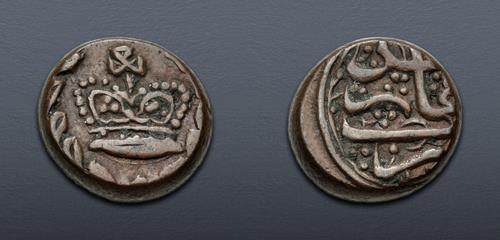
|
AFGHANISTAN, Second Anglo-Afghan War. British Occupation of Qandahar. AH 1296-1298 / AD 1878-1880. Æ Fulus (14mm, 4.86 g, 7h). Qandahar mint. Dated AH 1296 (AD 1878/9). VF.
Electronic Auction 560
Lot: 940. Estimated: $ 100
World, Bronze
Sold For $ 325. This amount does not include the buyer’s fee.
Go to Live
|
|
AFGHANISTAN, Second Anglo-Afghan War. British Occupation of Qandahar. AH 1296-1298 / AD 1878-1880. Æ Fulus (14mm, 4.86 g, 7h). Qandahar mint. Dated AH 1296 (AD 1878/9). Crown within wreath / Arabic inscruption in four lines. SICA 9, 1080; Spencer-Smith, Crown p. 209, fig. 1; Album 3253 note; KM 94. Brown surfaces, a few deposits. VF.
From the St. George Collection.
The mid to late 19th century saw central Asia transform into an international chessboard, as Britain and Russia played out the Great Game, manipulating regional and tribal entities to their advantage. In July 1878, an uninvited, yet not unwelcome, Russian diplomatic mission arrived in Kabul. This action incensed the British authorities in India, who ordered Sher Ali, the Amir of Afghanistan, to accept a British mission as well. The Amir staunchly refused, even going so far as to reject the mission sent by the British in September 1878.
In response, the British dispatched an army of 40,000 men across the Khyber Pass. With the Russians refusing to send aide, the Afghanis had little chance of defeating the superior invading army, and the British quickly occupied parts of the country. After Sher Ali’s death, his son, Mohammed Yaqub Khan, sued for peace with the Treaty of Gandamak in May 1879. The Afghans were allowed to maintain their own internal affairs, but were forced to acquiesce to the British for any foreign matters and to host a British envoy in Kabul, effectively making Afghanistan a puppet state. British forces remained in the area to put down various local uprisings, including a siege of Kandahar, eventually withdrawing their envoy and army in September 1880.
This fascinating piece was struck during the period of the occupation. Though it bears a British crown on the obverse, the coin more properly belongs to the vast series of Persian and Afghani civic coppers. These issues were struck under local authorities who routinely recalled and devalued the coppers, a process known as taghayyor dādan – “changing” the coinage. This abusive practice lead to a great variety of types, often featuring various animal or flower motifs. Accordingly, the types on this simple coin were likely not ordered by the occupation authorities, but rather placed by an opportunistic engraver eager to please the occupiers.
Closing Date and Time: 17 April 2024 at 15:13:00 ET.
All winning bids are subject to a 20% buyer’s fee.
|
